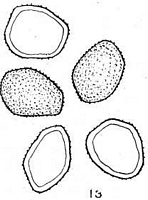|
 Anthracoidea sclerotiformis Anthracoidea sclerotiformis
SynonymsUstilago sclerotiformis
Cintractia sclerotiformis
BiostatusPresent in region - Indigenous. Non endemic
Images (click to enlarge) | 
Caption: Plate 47, Fig. 1. Cintractia sclerotiformis (C. & M.) G.H. Cunn. in the ovaries of Uncinia
riparia R. Br. ¾ natural size. |
Article: Cooke, M.C. (1888). Australasian fungi. Grevillea 17(81): 7-8.
Description: Black, compact, obovate, large (2 mm. diam), never becoming powdery,. spores subglobose,
dark umber (16-18 µ diam.). Epispore granulose.
Notes: Somewhat resembling U. marmorata, B., but that species has spores distinctly verrucose, in
the type specimens, although included by F. de Waldheim with the smooth-spored species.
Article: Cunningham, G.H. (1924). The Ustilagineae, or "smuts", of New Zealand. Transactions and Proceedings of the New Zealand Institute 55: 397-433 Wellington:.
Description: Sori in occasional ovaries, sometimes in all, at first partially concealed within the perigynium,
becoming exposed when compact, black, elliptical, up to 6 mm. long.
Spores subglobose to elliptical, commonly polygonal, 16-22 X 11-18 mmm.; epispore closely
and minutely verruculose, dark brown, 1-5 mmin. thick.
Distribution: Distribution: New Zealand.
Notes: The first two hosts are endemic, the third occurs also in Australia; all are widely distributed
throughout New Zealand (Cheeseman, 1906, pp. 801-3).
This is a true Cintractia, for a transverse section shows that it possesses all the characters of
this genus. The species is closely related to the preceding, but is separated by the
comparatively broader and smaller spores, more conspicuous markings, and thinner nature of
the epispore.
I have been unable to germinate the spores.
Article: Dingley, J.M. (1969). Records of plant diseases in New Zealand. New Zealand Department of Scientific and Industrial Research, Bulletin 192: 298 p. Wellington:.
Notes: Smut on seed heads of Uncinia have been recorded only from Wellington and the
South Island. The host plants and the smut fungus are endemic to New Zealand.
|